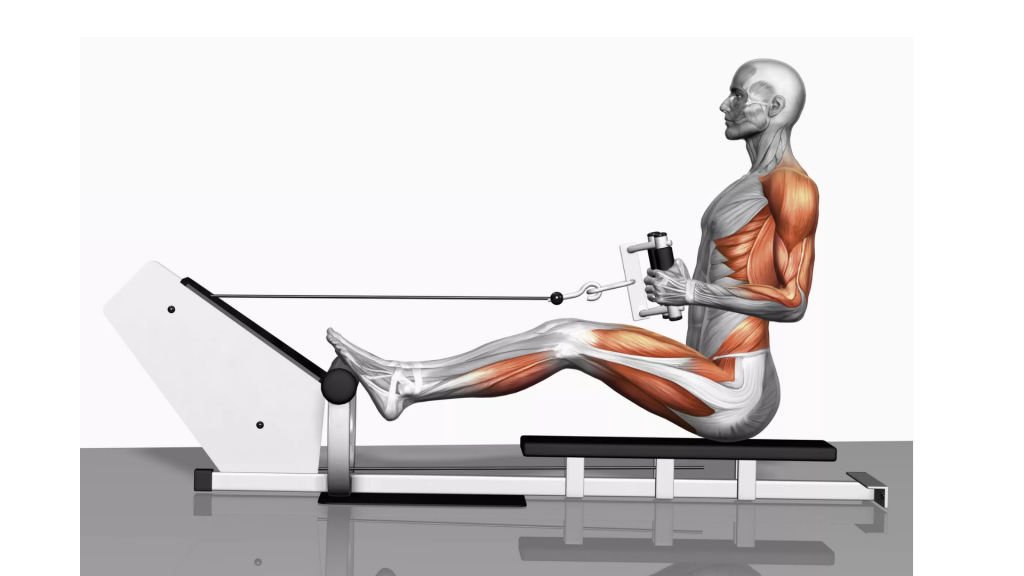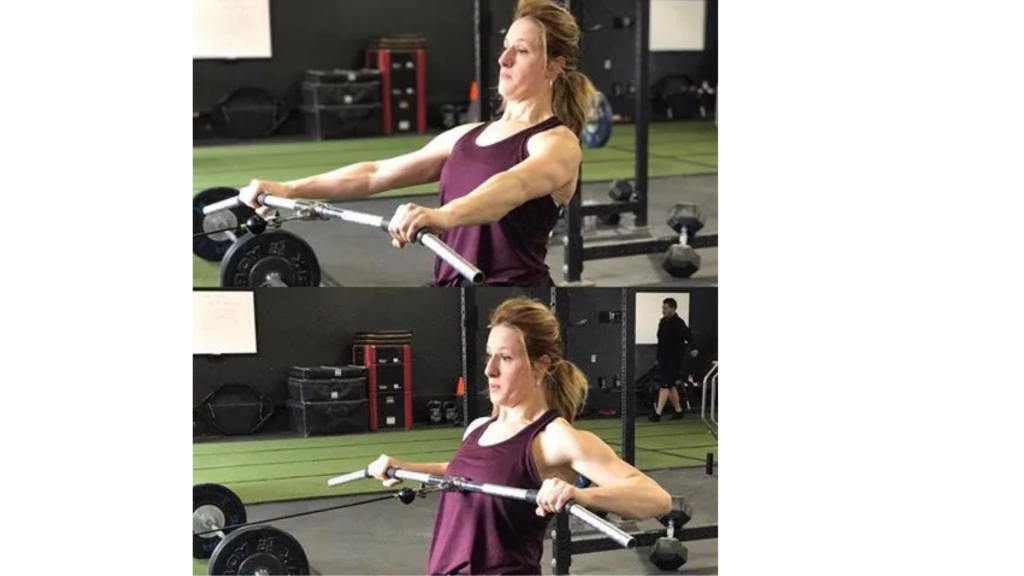One of the best workouts for building upper-body strength is the seated row. It’s a type of strength training that focuses on the upper back and arms.
It’s done by pulling a weighted handle on a seated row machine. Pulling a resistance band or utilizing a seated cable row machine are some options.
Much like close grip lat pulldown, this workout will tone and strengthen your upper body, which is important for everyday tasks like tugging. An upper body that is strong improves posture, protects the shoulders, and reduces the risk of injury.
Which muscles do seated rows use?

The sitting row engages various back and arm muscles. These are some of them:
- latissimus dorsi is a muscle in the back of the body (middle back)
- rhomboids are a type of rhombus (between shoulder blades)
- trapezius is a muscle in the trapezius muscle (neck, shoulders, and upper back)
- biceps brachii biceps brachii biceps brachi (front of upper arm)
The lats and rhomboids are the principal movers in the seated row. By aiding the lats and rhomboids, the trapezius and biceps aid movement.
How to do a standard seated row

Seated rows are commonly performed on a seated row machine or a seated cable row machine, and the instructions for both are nearly the same.
Adjust the seat and chest pad before you begin. The machine handles should be level with your shoulders.
Next:
- Sit erect on the bench with your knees bent and your feet on the floor or foot pads. Hold the handle or cord with your extended arms. Back and forth with your shoulders. Your core should be braced.
- Exhale. Pull the handle or cable with your elbows tucked tight and your back in a neutral position. 1 second of pause
- Count to three as you inhale and slowly stretch your arms.
- One set of 12 to 15 reps is sufficient.
How to do a wide-grip seated row

A thin grip is typically used for the seated row. A wide grasp, on the other hand, can be used to focus on the smaller back and arm muscles rather than the lats. The following muscles are among them:
- trapezius middle (upper back between shoulders)
- rhomboids are a type of rhombus (between shoulder blades)
- deltoids in the back (back shoulder)
You’ll need a seated cable machine with a straight-bar attachment to complete this version. With your arms slightly wider than shoulder-width apart, hold the bar. As usual, perform the seated row.
How to do a seated row with a resistance band

If you don’t have access to gym equipment, you can do seated rows with a resistance band.
This variation, like seated rows on a machine, targets the lats and rhomboids.
To do a seated row with a resistance band, follow these steps:
- Sit on the floor with your legs crossed in front of you. Slightly bend your knees. Wrap the band around your feet’s soles and grasp the ends in your hands, palms facing inward. Your core should be braced.
- Pull the band across your thighs with an exhale, keeping your elbows tucked in and your back neutral. Take a one-second break.
- Count to three as you inhale and slowly stretch your arms.
- Complete a 12- to 15-rep set.
Begin by using a light resistance band. You can utilize a heavier band as you gain strength.
The resistance band can also be wrapped around your hands to increase the intensity.
Common mistakes to avoid
To be efficient and safe, the seated row, like all workouts, requires good form and movement.
Avoid these typical blunders for the greatest results. If you require one-on-one assistance, speak with a personal trainer.
- Outward elbows. During the pulling phase, keep your elbows against your body (except during the wide-grip row). Lifting your elbows up and out engages your biceps rather than your lats and rhomboids.
- Shrugged shoulders. Keep your shoulders back and down as you draw the weight. When you shrug your shoulders toward your ears, you’re putting too much emphasis on the traps.
- Rounded back. Maintain a neutral back at all times. Engage your core muscles and keep your spine upright to avoid rounding or arching.
- Swinging torso. Keep your torso still. Otherwise, there will be no tension in the targeted muscles. Your torso will be stabilised if you brace your core during the activity.
- Rapid movements. Slowly do each rep to thoroughly stimulate your muscles. Avoid jerky and quick movements.
- Partial range of motion. For the best results, each exercise should go through the entire range of motion. While having a limited range of motion allows you to lift more weight, only half extending your arms will not adequately strengthen your muscles.
- Locked knees. Because locking your knees is demanding on the joints, it’s ideal to bend them slightly.
Modifications to try
Modifying your seated rows to match your fitness level is a terrific way to mix things up.
Make it easier
Begin with a lightweight and a low number of reps. Increase the weight and reps until you’ve mastered the movement with excellent form.
Make it harder
Try these tweaks for a more challenging exercise if your seated rows are too easy:
- Move the chest pad. Shift the chest pad away from your body when using a seated row machine. To keep still, your trunk will have to work harder.
- Use one arm at a time. With one foot on the floor and the other on the plate, sit on a seated cable row machine. Pull the cord along the side of your body with one arm.
- Extend the pause. stop for 3 to 5 seconds at the end of the tugging phase to push your muscles
- Extend the return. Returning at a slower pace will also enhance the intensity.
Safety tips
Always perform seated rows with proper form and movement to avoid injury. This includes the following:
bending your knees slightly while keeping your back straight and tucking your elbows in, moving slowly
Start with a lightweight. Using a weight that is excessively heavy might cause major back and shoulder pain.
If you have a current or previous back, shoulder, or arm ailment, consult your doctor or physical therapist before trying sitting rows. A personal trainer can show you how to work the same muscles in a safer way.
In the initial posture, you should only feel a slight stretch. If you experience any pain throughout the activity, stop immediately.

